|
Week 8: September 19-25, 2012 |
Welcome
to the McGill Bird Observatory weekly report.
Click here for a complete listing of our archives.
Comments or
questions are welcome at "mbo AT migrationresearch.org".
|
PICTURE
OF THE WEEK: |
|
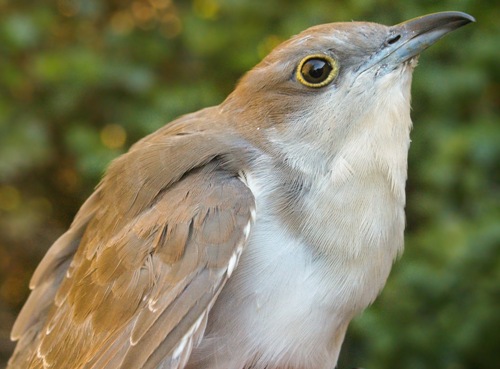
The highlight of the week was this hatch-year Black-billed Cuckoo, only the seventh
banded at MBO in 8 years, and the first since spring 2011. It was also the latest
ever fall record of the species at MBO.
(Photo by Simon Duval)
-
|
|
|
THIS WEEK |
THIS FALL |
2012 TOTAL |
SITE TOTAL |
|
# birds (and species) banded |
210 (36) |
1967 (74) |
3232 (84) |
38983 (108) |
|
# birds (and species) repeat |
65 (13) |
530 (35) |
868 (48) |
7281 (69) |
|
# birds (and species) return |
2 (2) |
60 (20) |
199 (27) |
1160 (38) |
|
# species observed |
87 |
133 |
162 |
207 |
|
# net hours |
514.0 |
4321.8 |
7581.6 |
66680.7 |
|
# birds banded / 100 net hours |
40.9 |
45.5 |
42.6 |
58.5 |
|
|
Note: table does not include nocturnal banding (owls) |
|
Banders-in-charge: Simon Duval, Gay Gruner
Assistants: Nicolas Bernier, Cindy Bouchard, Dawn Cruchet, David Davey, Rui de Jesus, Leah den Besten, Gail Desnoyers, Réjean Duval, Tammy Elliot, Michael Fleming, Nicki Fleming, Andray Gagné, Louise Gagné, Jo-Annie Gagnon, Marie-France Gagnon, Tiffany Gilchrist, Monique Groulx, Alison Hackney, James Junda, Lisa Keelty, Shelley Kirk, Patrick Laniel, Marie-Pier Laplante, Barbara MacDuff, Francine Marcoux, Betsy McFarlane, Ana Morales, Chris Murphy, Charla Patterson, Benoit Piquette, Geneviève Potvin, Catherine Russell, Marilou Skelling, Rodger and Elise Titman, Carine Touma
Notes: The momentum of migration tapered off toward the end of week 7, and that lull continued right through week 8. Except for a modest peak of 52 birds banded on Monday, the daily total ranged from only 14 to 36. Considering that two years ago, we banded 1279 birds in week 8, the pace felt quite slow. This week's results were actually quite similar to last year's, when 241 birds of 41 species were banded in week 8. However, thanks to the busier than average first half of the fall season, the cumulative total of 1967 birds banded to date is still the highest at this point in the season except for the unprecedented surge in 2010. Meanwhile the diversity observed this week and the species list for the season remain well above average, with the previous high count after the first 8 weeks being 130 in 2007. For the most part, weather continued to be good this week, although brief rainy spells reduced our hours a bit on three mornings.

Actually an even greater rarity at MBO than the Black-billed Cuckoo, the Wood Thrush above was only the sixth of its kind banded in MBO's history, but the second this year. Brown Creepers are only moderately more common, with this week's five (including the one below) bringing the cumulative total to 80 individuals.
(Photos by
Simon Duval)
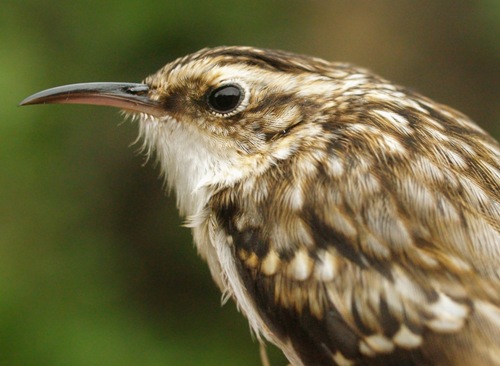
|
The highlight of this week's observations was a Tundra Swan, only MBO's second ever. The other species observed for the first time this year was American Pipit, while another four species were new for fall 2012: Peregrine Falcon, Killdeer, Great Black-backed Gull, and Wood Thrush. We banded our first Black-billed Cuckoo of the year, and first Wood Thrush and Yellow Palm Warbler of the fall, although we already banded our first Western Palm Warblers two weeks ago - reflecting the typical temporal pattern we've observed in the two subspecies over the years.
This week’s top 10 [last week's rank in brackets]
# individuals banded |
mean # individuals observed daily |
1. White-throated Sparrow (60) [3] |
1. Canada Goose (93) [2] |
2. Blue Jay (24) [-] |
2. Blue Jay (75) [1] |
3. Swainson's Thrush (20) [1] |
3. White-throated Sparrow (64) [3] |
4. Ruby-crowned Kinglet (15) [-] |
4. Red-winged Blackbird (50) [-] |
5. Gray-cheeked Thrush (10) [-] |
5. American Robin (38) [9] |
6. Song Sparrow (9) [6] |
6. American Crow (31) [6] |
7. Nashville Warbler (8) [6] |
7. Black-capped Chickadee (20) [7] |
8. Magnolia Warbler (7) [2] |
8. American Goldfinch (19) [4] |
9. Black-capped Chickadee (6) [-] |
9. Cedar Waxwing (9) [-] |
10. Brown Creeper (5) [-]
10. Golden-crowned Kinglet (5) [-]
|
10. Ring-billed Gull (8) [-] |
|
The strong flight of White-throated Sparrows continued, with another 60 individuals banded this week, adding to last week's 53 (and the 38 banded over the first six weeks of the fall program). This marks the fourth time in 8 years that White-throated Sparrows has been the top species banded in week 8 (and twice more it was the runner-up). For the second week in a row, there is a big surprise near the top of the list - this time Blue Jay in second place, with more individuals banded this week than all of last year, and an all-time single-week record. Last week's unexpected champion, Swainson's Thrush, was still quite common this week, landing in third place, and bringing the season total to 135 individuals banded, nearly 100 more than the previous fall record ... and there's no sign of them stopping yet! Gray-cheeked Thrushes were only half as numerous, but the ten banded this week was more than in any previous entire year - and again, easily a single-week record. Meanwhile, both Ruby-crowned and Golden-crowned Kinglets were new to the top ten this week, in advance of their traditional October peak in migration. Song Sparrow and Nashville Warbler numbers were similar to last week, the latter still far less common than usual. Magnolia Warblers are now tapering off, but closing in on 200 individuals for the season, still more than any other species. Black-capped Chickadee and Brown Creeper rounded out this week's top ten, the former seeming to be on the move in good numbers this fall, with a total of 51 already, and the latter an uncommon species making a very rare appearance on this list. Three warblers (Black-throated Green, Blackpoll, and Common Yellowthroat) and two others (Gray Catbird and American Goldfinch) were knocked off from last week's top ten. Of note, given the 881 Yellow-rumped Warblers banded in week 8 in 2010, this week we had only two!
The three most abundant species over the course of the week were again Canada Goose, Blue Jay, and White-throated Sparrow, although the top two swapped since last week, allowing Canada Goose to take top spot for week 8 for the fifth time in 8 years. Even though White-throated Sparrow topped the list of species banded this week, the numbers indicate that a relatively small percentage (14%) of the ones migrating through MBO made a stop in our nets. After dominating for much of the season, Common Grackles became scarce, with only 24 observed in total this week, whereas Red-winged Blackbirds surged into the top four, with a mean daily count of 50. Like Red-winged Blackbird, American Robin numbers typically increase toward the end of the season, and that spike already began to be apparent this week. American Crow and Black-capped Chickadee remained stable in sixth and seventh place, while American Goldfinches dropped off a bit in comparison with week 7. The crow numbers are actually unusually low for this time of year, the first time that the species has been outside the top three in week 8. This week there was a big drop off to ninth and tenth place, occupied by Cedar Waxwing and Ring-billed Gull. Those two newcomers displaced Swainson's Thrush and Magnolia Warbler, both nearing the end of their migration period.
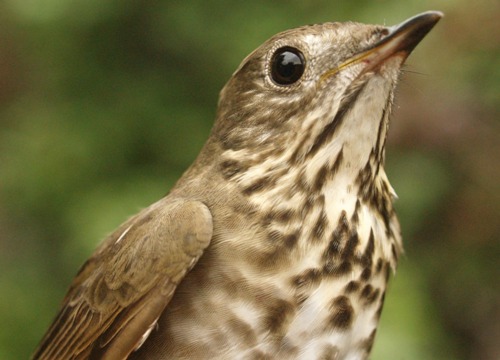
One of a record-setting ten Gray-cheeked Thrushes banded at MBO this week.
(Photo by
Simon Duval)
|
After nearly two months of our Fall Migration Monitoring Program, we've banded record numbers of three thrushes (Swainson's, Gray-cheeked, and Veery) and two finches (House and Purple), as well as Common Yellowthroat. On the other hand, we've had exceptionally few Nashville and Yellow-rumped Warblers. Once before we've had a modest week 8, followed by a dramatic influx of birds in week 9 - can history repeat itself?
|
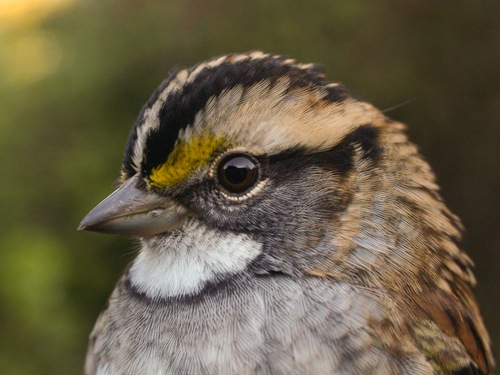
The dominant songbird of the week, White-throated Sparrow.
(Photo by Simon Duval)
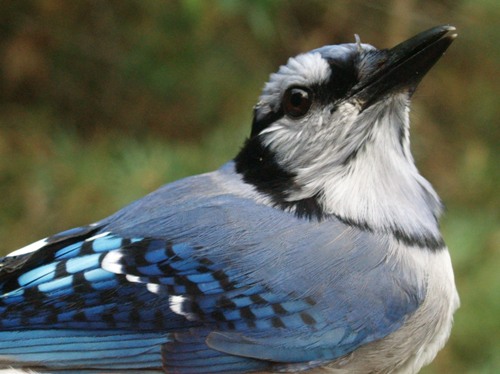
We have never before banded as many Blue Jays in a week - this was one of the 24 that we banded over the course of week 8.
(Photo by
Simon Duval)
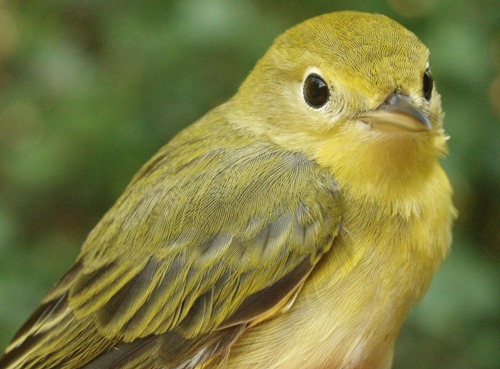
An exceptionally late Yellow Warbler - only the second one we have ever banded this far into the fall season.
(Photo by
Simon Duval)
|







